It was a random Wednesday morning that I learned something completely unexpected from the Danish people. My kids were in their second week at their new school in the bucolic village of Højmark and we were starting to fall into a daily rhythm. Mid-morning I noticed that my daughter, Arabelle, had forgotten her pencil case. I decided I would go ahead and bring it to her at school (since forgetting something of this importance is just the sort of thing that can throw off the entire day for a six-year-old). I loaded the baby into the stroller and walked the short but scenic two blocks to the school building.
As I approached the front entrance of the brick structure, I noticed through a large nearby window that a group was gathered in one of the basement rooms. This is a classroom that can most closely be equated to a “Home Ec” room in the States-equipped with several small kitchens and a few large tables for instruction. Around one of these tables I saw the principal with children gathered all around (In this small school the principal regularly teaches a few classes of his own). The group of students looked to be about Arabelle’s age, so I drew closer to the window to see if she was there. As I took a closer look, I thought I saw…but no, it couldn’t be! …but it was!
I headed into the building, down the stairs, and into the classroom. My eyes went first to Arabelle who was sitting at the far end of the table with her hands covering her eyes, and then to the principal, who was dangling a headless chicken by its rubbery orange feet and thrusting it around at the students so that anyone who wanted could get a good feel of its fine feathers.
I sidled past the students to get to my daughter. As I did so, I noticed that the table had a piece of cardboard placed on it, and on this cardboard a small, beady-eyed chicken head lay limply, its beak forever silenced, its eyes forever glassy.
When I reached Arabelle she still sat with her eyes covered, her body hunched. A teacher sat beside her–I’m not sure if the teacher was comforting Arabelle or merely explaining what was going on, since my daughter is new to Danish.
“Are you okay?” I whispered to Arabelle.
“I’m a little scared.” she admitted, eyes still covered. “The blood.”
I looked back over at the table and noticed a bit of blood on the cardboard and a few more drops spilled onto the tile floor. Really it wasn’t much, considering.
At this point it was time to pluck the feathers. Most of the Danish kids volunteered to join in and get in on some plucking action.
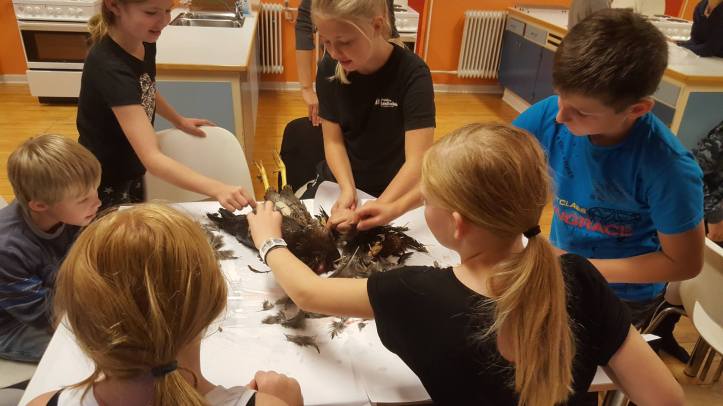
I was curious how these young, angelic children could be so un-phased by all the goings-on, while my child sat, unable to look–visibly trying to hide how upset she was. Was the difference in reactions simply random? Is my daughter just a particularly sensitive soul?( I think she is.) Or could the difference be more cultural–had these children already seen this kind of thing in the past? Is there any way it could be the Viking DNA showing up in the weirdest way?
I let Arabelle know that I had brought her pencil case, and then I took a seat. I wasn’t going anywhere!
Next, the children who had helped with the plucking dutifully washed their hands. As they returned to the table the principal picked up a pair of garden pruners and handily clipped off the chicken’s feet: One, two–quick snips was all it took. And now, finally, the Danish children reacted visibly and audibly, joining collectively in a chorus of “Owww!” (This word is the same in Danish and English…could it be the natural human expression of pain? [chicken pain])
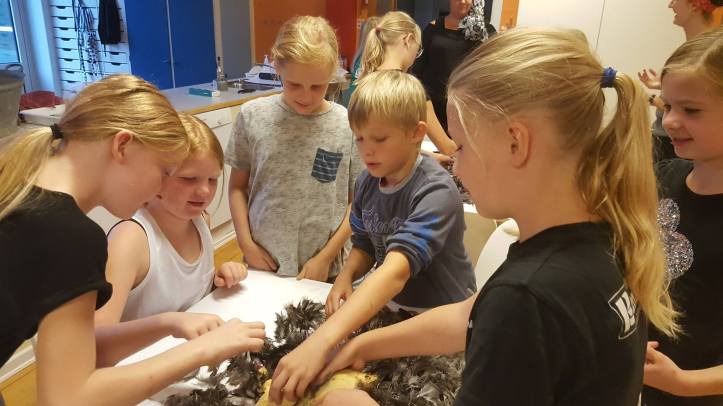
The principal held both yellow rubbery claws aloft and explained that the chicken used them to dig in the dirt, uncovering its food.
Finally he began retrieving the organs, holding up each slimy mass one at a time, explaining its name and function. Or at least that’s what a teacher translated for me–I, of course, had no clue what was actually being said in that collection of strange and indecipherable sounds they call Danish.
So–I thought while walking back home a short time later-was this chicken necropsy an unusual occurrence here in Denmark (due to my children attending a small country school? I was aware that there are farms bordering the school and it’s common place for the teachers and students to utilize them frequently, walking over to observe farm procedures, plantings, and even to harvest crops for their own “farm-to-table” meals at the school.)
With a little research I was able to discover that no, this chicken dissection was not a completely random, unusual occurrence within the country of Denmark.
As it turns out, public dissections, or autopsies, are a proud old Danish tradition, going back 400 years.
These dissections are considered to be purely educational and thus made public so that students may observe and learn. Perhaps you may remember a couple years back when Denmark made global headlines for publicly dissecting a giraffe with school children in attendance?
https://www.theguardian.com/world/2014/feb/09/marius-giraffe-killed-copenhagen-zoo-protests
And then there was the lion:
https://www.theguardian.com/commentisfree/2015/oct/15/dissect-lion-odense-zoo-schoolchildren-denmark
And there were have been many more including zebra, wolf, rabbit.
Such dissections are a popular activity for children during school holidays, with institutions such as the Copenhagen Zoo offering two events a day to meet public demand.
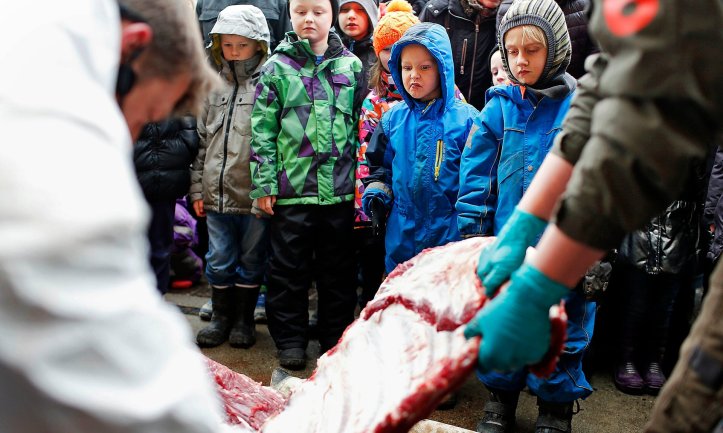
I’m pretty sure Americans wouldn’t stand for this–there would be outspoken groups like PETA that would never let it rest, but even regular Americans would find it disturbing. The majority of Danes, on the other hand, are okay with it. They consider public dissections, or autopsies, to be not gruesome but a valuable educational tool. So why the difference in mindsets?
One explanation is that in America we tend to put animals into two boxes: the cute ones that we anthropomorphize–pets and zoo animals (cough, cough Disney), and the ones destined for consumption–farm animals. In Denmark, until fairly recently a predominantly agricultural society, they don’t put so much stock in such categorization–animals are animals are animals.
I am an American. I was also a strict vegetarian for many years and still eat meat only on the rarest of occasions. So do I personally have a problem with the chicken necropsy that took place at my kids’ school?
At first I thought maybe I did. For a few moments as I first realized what was going on, I thought, “They can’t do this at a school, it’s gross.” Then I looked at my daughter, eyes covered and mouth pressed into a grimace and thought, “Well if anything’s going to turn kids into little vegetarians, it’s probably this!”
Vegetarianism aside, I decided ultimately that it is valuable for children to learn, in an appropriate manner, where their food comes from. We as Americans have intentionally disassociated ourselves from this concept–in our eyes meat comes from a slick pack in the grocery store, and we prefer not to think beyond that. But is it not hypocritical for us to consume meat without being willing to acknowledging the animals that gave their lives for it ?
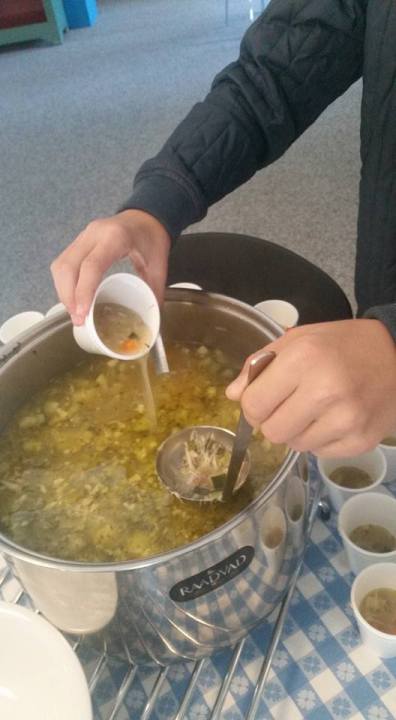
And yes, the chicken did eventually make its way to the pot, in the innocuous form of chicken soup. The students ate it as part of a meal that included fresh fruits and vegetables, planted and tended by the children on school grounds over the course of several months.
The meal gave me pause to think: the American public would find it right and proper that the children had tended those vegetables and knew exactly where their produce was coming from. Is it not just as appropriate (if not more so), that they also know where the meat–that they regularly consume–comes from?
Funnily enough, I did ask Arabelle–a few days after the autopsy incident–about whether her experience would dissuade her from eating chicken in the future. Her response? “Well, maybe just the kind of chicken that we eat, not the animal kind of chicken.”
Hey Højmark Skole, my daughter didn’t get it–she’s gonna need another demonstration!
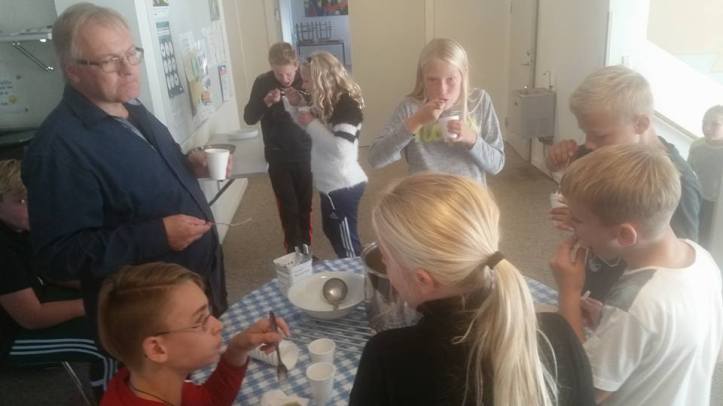
We dissected cats in high school in Anatomy & Physiology. Not the same though as dissecting and eating at such a young age, ha ha. I’m sure she will never forget it.
LikeLike